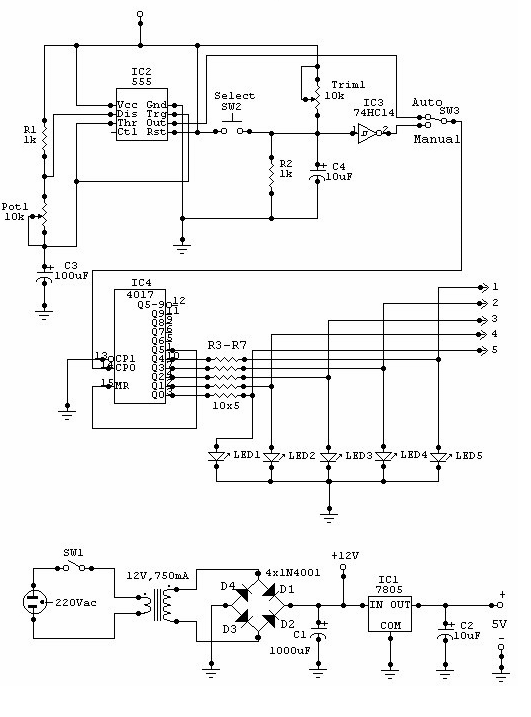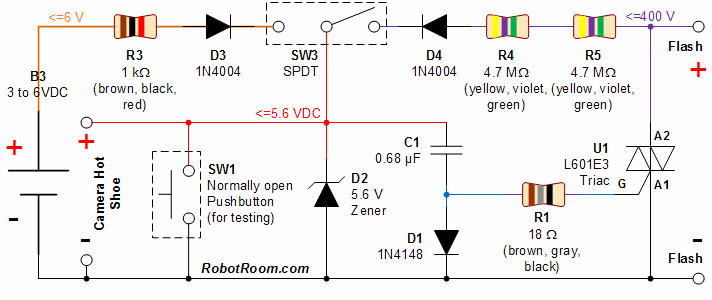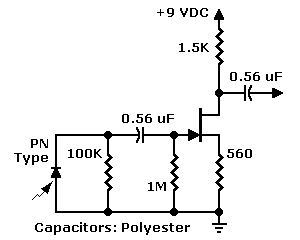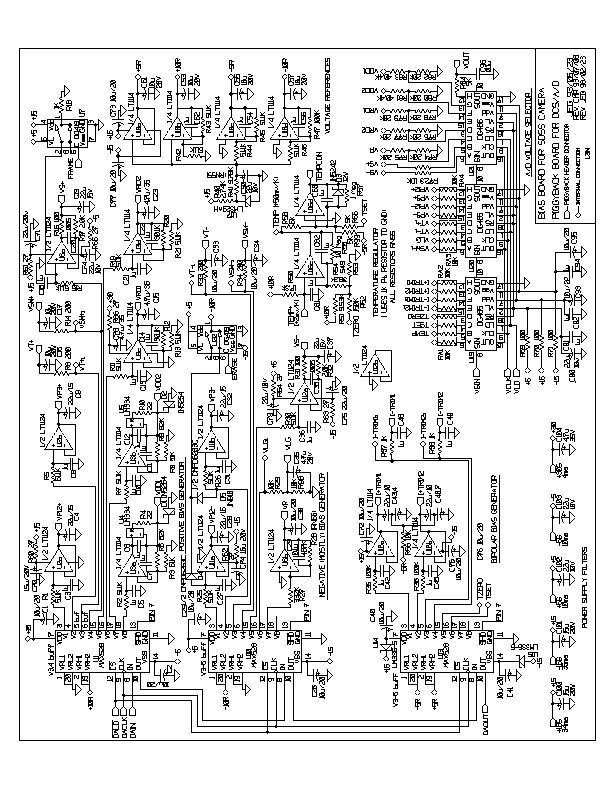
Camera Switcher

This circuit allows multiple cameras to be connected to a single monitor. It can be operated either manually or automatically. In automatic mode, a switch is connected to the output of a 555 astable multivibrator, which generates a continuous square wave to drive a 4017 decade counter. As the counter operates, five transistors switch sequentially. For example, when Q1 is activated, the relay connected to Q1 is energized, linking Out1 (Camera 1) to the input (Monitor). Similarly, when Q2 is activated, Out2 (Camera 2) connects to the input. In manual operation, pressing SW2 causes a transition from logic 0 to logic 1, which changes the output of the counter. Each press of SW2 advances the counter output. LED indicators are used to show which camera is currently connected to the monitor. Pot1 serves as an adjustment for the switching speed between cameras.
The circuit employs a 555 timer configured in astable mode to produce a square wave signal, which is fed into the clock input of a 4017 decade counter. The 4017 counter has ten outputs, but in this application, only the first five outputs are utilized to control the corresponding relays for the cameras. The output from the 555 timer determines the switching frequency of the cameras. The frequency can be adjusted using Pot1, allowing for flexibility in how quickly the camera feed switches.
Each output of the 4017 is connected to a transistor, which acts as a switch to control the relay for each camera. The relays are essential for connecting and disconnecting each camera from the monitor without any electrical interference. The activation of a transistor energizes its corresponding relay, allowing the selected camera to transmit its video feed to the monitor.
In manual mode, the user can control the switching of the cameras by pressing SW2. This switch generates a pulse that increments the counter, allowing the user to cycle through the cameras one at a time. The use of LED indicators provides visual feedback on which camera is currently active, enhancing the user experience. The entire system is designed to provide a seamless transition between multiple camera feeds, making it suitable for various applications such as security monitoring, live event broadcasting, or any scenario requiring multiple video inputs to a single output display.This circuit can be used for multiple cameras with one monitor. The circuit can be operated manually or automatically. When operated automatically the switch will be connected to the output of 555 astable multivibrator that will send a continous square wave in the 4017 counter. When counter is running, the 5 transistor will switch one by one. For example; when Q1 is turned on the relay connected to Q1 will energized which will connect Out1 (Camera1) with the input (Monitor). If Q2 is turned on, Out2 (Camera2) will connect to input. For manual operation; each time the SW2 is push, transition will occur(Logic 0 to logic 1). That transition will change the output of the counter. Every time the SW2 is push, the counter output will change. LED ½s are indicator to monitor which camera is connected to monitor. Pot1 is the adjustment for switching speed for the camera. Be the first of your friends to get free diy electronics projects, circuits diagrams, hacks, mods, gadgets & gizmo automatically each time we publish.
Your email address & privacy are safe with us ! 🔗 External reference
The circuit employs a 555 timer configured in astable mode to produce a square wave signal, which is fed into the clock input of a 4017 decade counter. The 4017 counter has ten outputs, but in this application, only the first five outputs are utilized to control the corresponding relays for the cameras. The output from the 555 timer determines the switching frequency of the cameras. The frequency can be adjusted using Pot1, allowing for flexibility in how quickly the camera feed switches.
Each output of the 4017 is connected to a transistor, which acts as a switch to control the relay for each camera. The relays are essential for connecting and disconnecting each camera from the monitor without any electrical interference. The activation of a transistor energizes its corresponding relay, allowing the selected camera to transmit its video feed to the monitor.
In manual mode, the user can control the switching of the cameras by pressing SW2. This switch generates a pulse that increments the counter, allowing the user to cycle through the cameras one at a time. The use of LED indicators provides visual feedback on which camera is currently active, enhancing the user experience. The entire system is designed to provide a seamless transition between multiple camera feeds, making it suitable for various applications such as security monitoring, live event broadcasting, or any scenario requiring multiple video inputs to a single output display.This circuit can be used for multiple cameras with one monitor. The circuit can be operated manually or automatically. When operated automatically the switch will be connected to the output of 555 astable multivibrator that will send a continous square wave in the 4017 counter. When counter is running, the 5 transistor will switch one by one. For example; when Q1 is turned on the relay connected to Q1 will energized which will connect Out1 (Camera1) with the input (Monitor). If Q2 is turned on, Out2 (Camera2) will connect to input. For manual operation; each time the SW2 is push, transition will occur(Logic 0 to logic 1). That transition will change the output of the counter. Every time the SW2 is push, the counter output will change. LED ½s are indicator to monitor which camera is connected to monitor. Pot1 is the adjustment for switching speed for the camera. Be the first of your friends to get free diy electronics projects, circuits diagrams, hacks, mods, gadgets & gizmo automatically each time we publish.
Your email address & privacy are safe with us ! 🔗 External reference





